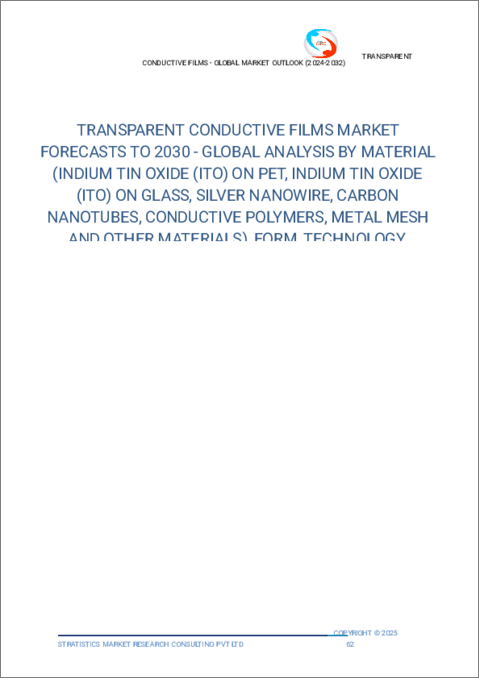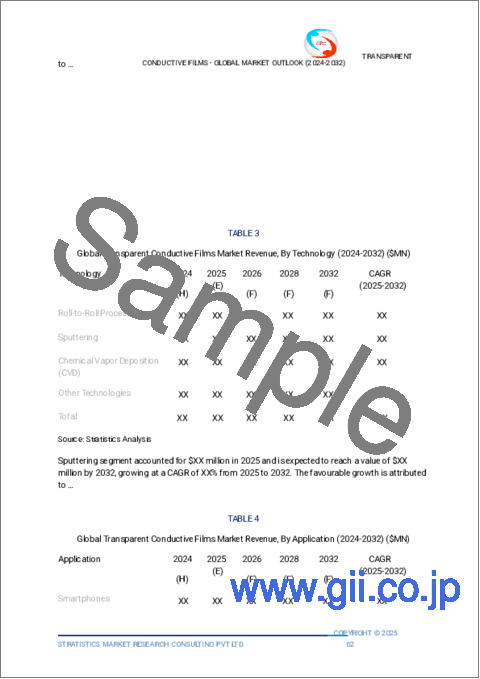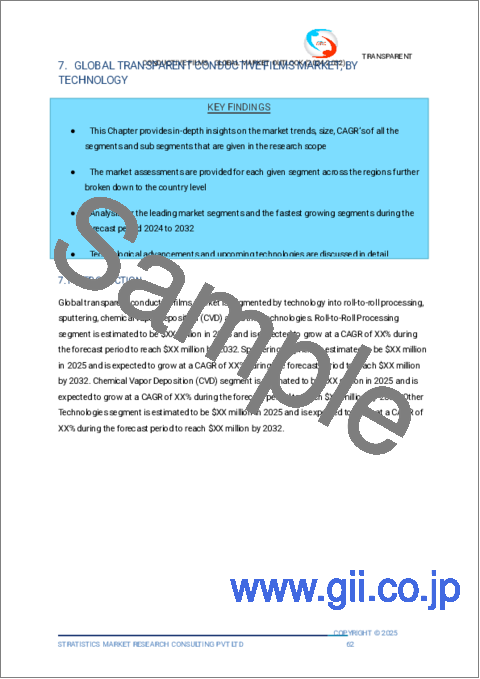|
|
市場調査レポート
商品コード
1551271
透明導電性フィルムの2030年までの市場予測:材料別、形状別、技術別、用途別、エンドユーザー別、地域別の世界分析Transparent Conductive Films Market Forecasts to 2030 - Global Analysis By Material, Form, Technology, Application, End User and By Geography |
||||||
カスタマイズ可能
|
|||||||
| 透明導電性フィルムの2030年までの市場予測:材料別、形状別、技術別、用途別、エンドユーザー別、地域別の世界分析 |
|
出版日: 2024年09月06日
発行: Stratistics Market Research Consulting
ページ情報: 英文 200+ Pages
納期: 2~3営業日
|
- 全表示
- 概要
- 図表
- 目次
Stratistics MRCによると、透明導電性フィルムの世界市場は2024年に79億米ドルを占め、予測期間中のCAGRは12.8%で成長し、2030年には163億米ドルに達する見込みです。
透明導電性フィルム(TCF)は、可視光線に対して透明であると同時に導電性を有する材料です。これらのフィルムは通常、導電性材料の薄い層で、光を通すと同時に電気を通します。TCFは一般的に、酸化インジウムスズ(ITO)、銀ナノワイヤー、カーボンナノチューブ、グラフェン、導電性ポリマーなどの材料から作られています。タッチスクリーン、OLEDディスプレイ、太陽電池、フレキシブル・エレクトロニクス、各種センサーなどに広く使われています。TCFは透明な電子デバイスの製造を可能にし、フレキシブルディスプレイや折りたたみ式ディスプレイのようなイノベーションを可能にするほか、光の反射を抑えることで太陽電池の効率を向上させる。
電子情報技術産業協会(JEITA)によると、世界のエレクトロニクス・IT産業の生産額は2021年の3兆3,602億米ドルに対し、2022年は3兆4,368億米ドルと推定され、前年比1%の成長率を記録しました。
スマートフォン、タブレット、その他タッチスクリーン・デバイスの普及
モバイル機器に5Gや人工知能などの先端技術が統合されることで、ユーザー体験が向上し、より優れたディスプレイ技術へのニーズが高まっています。TCFはこうした進歩において重要な役割を担っており、特にスマートフォンやタブレット端末では高い透明性、導電性、フレキシブルで折り畳み可能なスクリーンが求められる傾向にあるため、フレキシブルでありながら性能を維持できる新しいタイプのTCFの開発が必要となっています。このシフトは、TCF市場における技術革新を促し、酸化インジウム・スズ(ITO)のような従来の材料よりも優れた性能を提供するグラフェンや銀ナノ構造のような代替材料の探求につながっています。
原材料の高騰
原材料、特にインジウムのようなレアメタルの価格上昇は、TCFメーカーの製造コスト上昇につながります。ITOはTCFの伝統的な材料であるため、そのコスト上昇は透明導電性フィルムの全体的な価格設定に直接影響します。このため、メーカーの利益率が制限され、消費者の価格上昇につながる可能性があり、価格に敏感な市場におけるTCFの需要が減少する可能性があります。
ディスプレイ技術の進歩
特にスマートフォン、タブレット、テレビなどのディスプレイ技術の急速な進化が、TCFの需要を押し上げています。高度なタッチスクリーンやOLEDディスプレイを搭載する機器が増えるにつれ、高性能な透明導電材料へのニーズが高まっています。ディスプレイ性能の向上が求められる中、メーカーは従来の酸化インジウム・スズ(ITO)以外の革新的な材料を模索しています。銀ナノワイヤー、金属メッシュ、導電性ポリマーなどの代替材料が、柔軟性、透明性、導電性の要件を満たすために開発されています。
代替技術との競合
メーカーや新興国市場がITOの代替技術を模索する中、従来のTCFの市場シェアが脅かされています。例えば、銀ナノワイヤーや金属メッシュは、同等あるいはそれ以上の導電性と柔軟性を、潜在的に低コストで提供できます。この変化は、ITOベースのTCFの需要減少につながり、従来の材料に重点的に投資してきた企業の収益に影響を与える可能性があります。このように、新しい材料が利用可能になると、TCFの価格が下がる可能性があるため、従来のメーカーは競争力を維持するために価格を下げざるを得なくなる可能性があります。
COVID-19の影響:
COVID-19の流行は透明導電性フィルム(TCF)市場に大きな影響を与えました。製造工場が閉鎖され、サプライチェーンが寸断されたため、TCFの需要は特にエレクトロニクス分野で減少しています。インジウムのような原材料の不足がコストを押し上げ、景気後退がTCFに依存するスマートフォンやタブレットのような機器に対する消費者の支出を減らしています。しかし、パンデミックによって、ヘルスケア用途のタッチスクリーンやフレキシブルディスプレイなど、TCFを利用する技術の採用も加速しています。
予測期間中、カーボンナノチューブセグメントが最大になる見込み
カーボンナノチューブは、卓越した導電性と機械的強度を持ち、酸化インジウム・スズ(ITO)のような従来の材料に代わる望ましい材料であるため、予測期間中に最大となる見込みです。そのユニークな特性は、高い導電性だけでなく、フレキシブルで軽量なTCFの製造を可能にし、フレキシブル・ディスプレイやウェアラブル・テクノロジーといった最新のアプリケーションにとって極めて重要です。
予測期間中、フレキシブルフィルム分野のCAGRが最も高くなると予想されます。
フレキシブルフィルム分野は、予測期間中に最も高いCAGRを示すと予想されます。銀ナノワイヤー、金属メッシュ、導電性ポリマーなどの材料は、ITOに比べて優れた柔軟性と耐久性を提供します。例えば、カーボンナノチューブは優れた電気的・機械的特性を持ち、フレキシブルTCFに理想的な材料です。
最大のシェアを占める地域
特にスマートフォン、タブレット、ウェアラブルなどの民生用電子機器の急増が主な促進要因となっています。これらの機器にタッチスクリーンやOLEDのような高度なディスプレイ技術が搭載されるようになり、高性能TCFの需要が大幅に増加しています。
CAGRが最も高い地域:
アジア太平洋地域は、透明導電性フィルムの生産技術の進歩がメーカーに新たな機会をもたらしているため、予測期間中最も高いCAGRを維持すると予測されます。銀ナノワイヤーやカーボンナノチューブの開発など、材料の革新によりTCFの性能と柔軟性が向上し、フレキシブルディスプレイやウェアラブルデバイスなど、より幅広い用途に適しています。
無料カスタマイズサービス:
本レポートをご購読のお客様には、以下の無料カスタマイズオプションのいずれかをご提供いたします:
- 企業プロファイル
- 追加市場プレーヤーの包括的プロファイリング(3社まで)
- 主要企業のSWOT分析(3社まで)
- 地域セグメンテーション
- 顧客の関心に応じた主要国の市場推計・予測・CAGR(注:フィージビリティチェックによる)
- 競合ベンチマーキング
- 製品ポートフォリオ、地理的プレゼンス、戦略的提携に基づく主要企業のベンチマーキング
目次
第1章 エグゼクティブサマリー
第2章 序文
- 概要
- ステークホルダー
- 調査範囲
- 調査手法
- データマイニング
- データ分析
- データ検証
- 調査アプローチ
- 調査情報源
- 1次調査情報源
- 2次調査情報源
- 前提条件
第3章 市場動向分析
- 促進要因
- 抑制要因
- 機会
- 脅威
- 技術分析
- 用途分析
- エンドユーザー分析
- 新興市場
- COVID-19の影響
第4章 ポーターのファイブフォース分析
- 供給企業の交渉力
- 買い手の交渉力
- 代替品の脅威
- 新規参入業者の脅威
- 競争企業間の敵対関係
第5章 世界の透明導電性フィルム市場:材料別
- PET上のインジウムスズ酸化物(ITO)
- ガラス上のインジウムスズ酸化物(ITO)
- 銀ナノワイヤー
- カーボンナノチューブ
- 導電性ポリマー
- 金属メッシュ
- その他の材料
第6章 世界の透明導電性フィルム市場:形状別
- 硬質フィルム
- 軟質フィルム
第7章 世界の透明導電性フィルム市場:技術別
- ロールツーロール処理
- スパッタリング
- 化学蒸着法(CVD)
- その他の技術
第8章 世界の透明導電性フィルム市場:用途別
- スマートフォン
- タブレット
- ノートパソコン
- LCDおよびLEDモニターとテレビ
- ウェアラブルデバイス
- OLED照明
- 太陽光発電
- その他の用途
第9章 世界の透明導電性フィルム市場:エンドユーザー別
- 家電
- 自動車
- エネルギー
- ヘルスケア
- 小売り
- その他のエンドユーザー
第10章 世界の透明導電性フィルム市場:地域別
- 北米
- 米国
- カナダ
- メキシコ
- 欧州
- ドイツ
- 英国
- イタリア
- フランス
- スペイン
- その他欧州
- アジア太平洋
- 日本
- 中国
- インド
- オーストラリア
- ニュージーランド
- 韓国
- その他アジア太平洋地域
- 南米
- アルゼンチン
- ブラジル
- チリ
- その他南米
- 中東・アフリカ
- サウジアラビア
- アラブ首長国連邦
- カタール
- 南アフリカ
- その他中東とアフリカ
第11章 主な発展
- 契約、パートナーシップ、コラボレーション、合弁事業
- 買収と合併
- 新製品発売
- 事業拡大
- その他の主要戦略
第12章 企業プロファイリング
- 3M
- Abrisa Technologies
- C3Nano
- Cambrios Technologies Corporation
- Canatu Oy
- DONTECH Inc.
- Dupont Teijin Films
- Eastman Kodak Company
- Fujifilm Holdings Corporation
- Gunze
- Hitachi Chemical Co. Ltd
- MNTech
- Nano-C
- Nitto Denko Corporation
- Oike & Co., Ltd.
- TDK Corporation
- Toray Advanced Film Co Ltd
- TOYOBO Co., Ltd.
List of Tables
- Table 1 Global Transparent Conductive Films Market Outlook, By Region (2022-2030) ($MN)
- Table 2 Global Transparent Conductive Films Market Outlook, By Material (2022-2030) ($MN)
- Table 3 Global Transparent Conductive Films Market Outlook, By Indium Tin Oxide (ITO) on PET (2022-2030) ($MN)
- Table 4 Global Transparent Conductive Films Market Outlook, By Indium Tin Oxide (ITO) on Glass (2022-2030) ($MN)
- Table 5 Global Transparent Conductive Films Market Outlook, By Silver Nanowire (2022-2030) ($MN)
- Table 6 Global Transparent Conductive Films Market Outlook, By Carbon Nanotubes (2022-2030) ($MN)
- Table 7 Global Transparent Conductive Films Market Outlook, By Conductive Polymers (2022-2030) ($MN)
- Table 8 Global Transparent Conductive Films Market Outlook, By Metal Mesh (2022-2030) ($MN)
- Table 9 Global Transparent Conductive Films Market Outlook, By Other Materials (2022-2030) ($MN)
- Table 10 Global Transparent Conductive Films Market Outlook, By Form (2022-2030) ($MN)
- Table 11 Global Transparent Conductive Films Market Outlook, By Rigid Films (2022-2030) ($MN)
- Table 12 Global Transparent Conductive Films Market Outlook, By Flexible Films (2022-2030) ($MN)
- Table 13 Global Transparent Conductive Films Market Outlook, By Technology (2022-2030) ($MN)
- Table 14 Global Transparent Conductive Films Market Outlook, By Roll-to-Roll Processing (2022-2030) ($MN)
- Table 15 Global Transparent Conductive Films Market Outlook, By Sputtering (2022-2030) ($MN)
- Table 16 Global Transparent Conductive Films Market Outlook, By Chemical Vapor Deposition (CVD) (2022-2030) ($MN)
- Table 17 Global Transparent Conductive Films Market Outlook, By Other Technologies (2022-2030) ($MN)
- Table 18 Global Transparent Conductive Films Market Outlook, By Application (2022-2030) ($MN)
- Table 19 Global Transparent Conductive Films Market Outlook, By Smartphones (2022-2030) ($MN)
- Table 20 Global Transparent Conductive Films Market Outlook, By Tablets (2022-2030) ($MN)
- Table 21 Global Transparent Conductive Films Market Outlook, By Laptops & Notebooks (2022-2030) ($MN)
- Table 22 Global Transparent Conductive Films Market Outlook, By LCD & LED Monitors and TVs (2022-2030) ($MN)
- Table 23 Global Transparent Conductive Films Market Outlook, By Wearable Devices (2022-2030) ($MN)
- Table 24 Global Transparent Conductive Films Market Outlook, By OLED Lighting (2022-2030) ($MN)
- Table 25 Global Transparent Conductive Films Market Outlook, By Solar Photovoltaic (2022-2030) ($MN)
- Table 26 Global Transparent Conductive Films Market Outlook, By Other Applications (2022-2030) ($MN)
- Table 27 Global Transparent Conductive Films Market Outlook, By End User (2022-2030) ($MN)
- Table 28 Global Transparent Conductive Films Market Outlook, By Consumer Electronics (2022-2030) ($MN)
- Table 29 Global Transparent Conductive Films Market Outlook, By Automotive (2022-2030) ($MN)
- Table 30 Global Transparent Conductive Films Market Outlook, By Energy (2022-2030) ($MN)
- Table 31 Global Transparent Conductive Films Market Outlook, By Healthcare (2022-2030) ($MN)
- Table 32 Global Transparent Conductive Films Market Outlook, By Retail (2022-2030) ($MN)
- Table 33 Global Transparent Conductive Films Market Outlook, By Other End Users (2022-2030) ($MN)
Note: Tables for North America, Europe, APAC, South America, and Middle East & Africa Regions are also represented in the same manner as above.
According to Stratistics MRC, the Global Transparent Conductive Films Market is accounted for $7.9 billion in 2024 and is expected to reach $16.3 billion by 2030 growing at a CAGR of 12.8% during the forecast period. Transparent Conductive Films (TCFs) are materials that are both transparent to visible light and electrically conductive. These films are typically thin layers of conductive materials that allow light to pass through while also conducting electricity. TCFs are commonly made from materials like indium tin oxide (ITO), silver nanowires, carbon nanotubes, graphene, and conductive polymers. They are widely used in touchscreens, OLED displays, solar cells, flexible electronics, and various sensors. TCFs enable the production of transparent electronic devices, allowing for innovations like flexible and foldable displays, as well as improving the efficiency of solar cells by reducing light reflection.
According to the Japan Electronics and Information Technology Industries Association (JEITA), the production by the global electronics and IT industry was estimated at USD 3,436.8 billion in 2022, registering a growth rate of 1% year on year, compared to USD 3,360.2 billion in 2021.
Market Dynamics:
Driver:
Proliferation of smartphones, tablets, and other touchscreen devices
The integration of advanced technologies such as 5G and artificial intelligence in mobile devices enhances user experiences, increasing the need for better display technologies. TCFs play a crucial role in these advancements, particularly in devices that require high transparency, conductivity and trend towards flexible and foldable screens in smartphones and tablets necessitates the development of new types of TCFs that can maintain performance while being flexible. This shift is prompting innovation within the TCF market, leading to the exploration of alternative materials like graphene and silver nanostructures, which offer better performance than traditional materials like indium tin oxide (ITO).
Restraint:
High cost of raw materials
The increasing prices of raw materials, especially rare metals like indium, lead to higher production costs for TCF manufacturers. As ITO is the traditional material for TCFs, its rising costs directly affect the overall pricing of transparent conductive films. This can limit profit margins for manufacturers and may lead to increased prices for consumers, potentially reducing demand for TCFs in price-sensitive markets
Opportunity:
Advancements in display technology
The rapid evolution of display technologies, particularly in smartphones, tablets, and televisions, is driving the demand for TCFs. As more devices incorporate advanced touchscreens and OLED displays, the need for high-performance transparent conductive materials is growing. With the push for better display performance, manufacturers are exploring innovative materials beyond traditional indium tin oxide (ITO). Alternatives like silver nanowires, metal meshes, and conductive polymers are being developed to meet the requirements for flexibility, transparency, and conductivity.
Threat:
Competition from alternative technologies
As manufacturers and developers explore alternatives to ITO, the market share of traditional TCFs is threatened. For instance, silver nanowires and metal meshes can offer comparable or even superior conductivity and flexibility at potentially lower costs. This shift can lead to a reduction in demand for ITO-based TCFs, impacting revenues for companies heavily invested in traditional materials. Thus as new materials become available; they can drive down prices for TCFs, which may force traditional manufacturers to lower their prices to remain competitive.
Covid-19 Impact:
The COVID-19 pandemic has significantly impacted the Transparent Conductive Films (TCFs) market. With manufacturing plants shut down and supply chains disrupted, demand for TCFs has declined, particularly in the electronics sector. The shortage of raw materials like indium has driven up costs, while the economic downturn has reduced consumer spending on devices like smartphones and tablets that rely on TCFs. However, the pandemic has also accelerated the adoption of technologies that utilize TCFs, such as touchscreens and flexible displays in healthcare applications.
The carbon nanotubes segment is expected to be the largest during the forecast period
The carbon nanotubes is expected to be the largest during the forecast period as they offer exceptional electrical conductivity and mechanical strength, making them a desirable alternative to traditional materials like indium tin oxide (ITO). Their unique properties enable the production of TCFs that are not only highly conductive but also flexible and lightweight, which is crucial for modern applications such as flexible displays and wearable technology.
The flexible films segment is expected to have the highest CAGR during the forecast period
The flexible films segment is expected to have the highest CAGR during the forecast period manufacturers are exploring alternative materials beyond traditional indium tin oxide (ITO). Materials like silver nanowires, metal meshes, and conductive polymers offer better flexibility and durability compared to ITO. For example, carbon nanotubes have excellent electrical and mechanical properties, making them an ideal material for flexible TCFs
Region with largest share:
North America is projected to hold the largest market share during the forecast period owing to the surge in the consumer electronics sector, particularly for smartphones, tablets, and wearables, is a primary driver. As these devices increasingly incorporate touchscreens and advanced display technologies like OLED, the demand for high-performance TCFs has risen significantly
Region with highest CAGR:
Asia Pacific is projected to hold the highest CAGR over the forecast period owing to advancements in production technologies for transparent conductive films are creating new opportunities for manufacturers. Innovations in materials, such as the development of silver nanowires and carbon nanotubes, are improving the performance and flexibility of TCFs, making them suitable for a wider range of applications, including flexible displays and wearable devices
Key players in the market
Some of the key players in Transparent Conductive Films market include 3M, Abrisa Technologies, C3Nano, Cambrios Technologies Corporation, Canatu Oy, DONTECH Inc., Dupont Teijin Films, Eastman Kodak Company, Fujifilm Holdings Corporation, Gunze, Hitachi Chemical Co. Ltd, MNTech, Nano-C, Nitto Denko Corporation, Oike & Co., Ltd., TDK Corporation, Toray Advanced Film Co Ltd and TOYOBO Co., Ltd.
Key Developments:
In August 2024, Hitachi High-Tech Launches New Tabletop Microscopes with Enhanced Usability: TM4000PlusIII and TM4000III. These new models are part of Hitachi's ongoing efforts to provide cutting-edge technology in a compact, easy-to-use format, making advanced microscopy more accessible to users across various fields.
In July 2024, 3M invests in green hydrogen leader Ohmium in continuing effort to advance breakthrough climate technologies. The investment is part of 3M's commitment to advancing technologies that support the transition to a low-carbon economy and may help the company explore further decarbonizing its own operations.
In April 2024, 3M launches new Verify app to help tackle counterfeit personal protective equipment. Instead they are made by fraudsters using unknown processes and materials without quality control. Depending on the type of product, using a counterfeit product could put a person's safety at risk.
Materials Covered:
- Indium Tin Oxide (ITO) on PET
- Indium Tin Oxide (ITO) on Glass
- Silver Nanowire
- Carbon Nanotubes
- Conductive Polymers
- Metal Mesh
- Other Materials
Forms Covered:
- Rigid Films
- Flexible Films
Technologies Covered:
- Roll-to-Roll Processing
- Sputtering
- Chemical Vapor Deposition (CVD)
- Other Technologies
Applications Covered:
- Smartphones
- Tablets
- Laptops & Notebooks
- LCD & LED Monitors and TVs
- Wearable Devices
- OLED Lighting
- Solar Photovoltaic
- Other Applications
End Users Covered:
- Consumer Electronics
- Automotive
- Energy
- Healthcare
- Retail
- Other End Users
Regions Covered:
- North America
- US
- Canada
- Mexico
- Europe
- Germany
- UK
- Italy
- France
- Spain
- Rest of Europe
- Asia Pacific
- Japan
- China
- India
- Australia
- New Zealand
- South Korea
- Rest of Asia Pacific
- South America
- Argentina
- Brazil
- Chile
- Rest of South America
- Middle East & Africa
- Saudi Arabia
- UAE
- Qatar
- South Africa
- Rest of Middle East & Africa
What our report offers:
- Market share assessments for the regional and country-level segments
- Strategic recommendations for the new entrants
- Covers Market data for the years 2022, 2023, 2024, 2026, and 2030
- Market Trends (Drivers, Constraints, Opportunities, Threats, Challenges, Investment Opportunities, and recommendations)
- Strategic recommendations in key business segments based on the market estimations
- Competitive landscaping mapping the key common trends
- Company profiling with detailed strategies, financials, and recent developments
- Supply chain trends mapping the latest technological advancements
Free Customization Offerings:
All the customers of this report will be entitled to receive one of the following free customization options:
- Company Profiling
- Comprehensive profiling of additional market players (up to 3)
- SWOT Analysis of key players (up to 3)
- Regional Segmentation
- Market estimations, Forecasts and CAGR of any prominent country as per the client's interest (Note: Depends on feasibility check)
- Competitive Benchmarking
- Benchmarking of key players based on product portfolio, geographical presence, and strategic alliances
Table of Contents
1 Executive Summary
2 Preface
- 2.1 Abstract
- 2.2 Stake Holders
- 2.3 Research Scope
- 2.4 Research Methodology
- 2.4.1 Data Mining
- 2.4.2 Data Analysis
- 2.4.3 Data Validation
- 2.4.4 Research Approach
- 2.5 Research Sources
- 2.5.1 Primary Research Sources
- 2.5.2 Secondary Research Sources
- 2.5.3 Assumptions
3 Market Trend Analysis
- 3.1 Introduction
- 3.2 Drivers
- 3.3 Restraints
- 3.4 Opportunities
- 3.5 Threats
- 3.6 Technology Analysis
- 3.7 Application Analysis
- 3.8 End User Analysis
- 3.9 Emerging Markets
- 3.10 Impact of Covid-19
4 Porters Five Force Analysis
- 4.1 Bargaining power of suppliers
- 4.2 Bargaining power of buyers
- 4.3 Threat of substitutes
- 4.4 Threat of new entrants
- 4.5 Competitive rivalry
5 Global Transparent Conductive Films Market, By Material
- 5.1 Introduction
- 5.2 Indium Tin Oxide (ITO) on PET
- 5.3 Indium Tin Oxide (ITO) on Glass
- 5.4 Silver Nanowire
- 5.5 Carbon Nanotubes
- 5.6 Conductive Polymers
- 5.7 Metal Mesh
- 5.8 Other Materials
6 Global Transparent Conductive Films Market, By Form
- 6.1 Introduction
- 6.2 Rigid Films
- 6.3 Flexible Films
7 Global Transparent Conductive Films Market, By Technology
- 7.1 Introduction
- 7.2 Roll-to-Roll Processing
- 7.3 Sputtering
- 7.4 Chemical Vapor Deposition (CVD)
- 7.5 Other Technologies
8 Global Transparent Conductive Films Market, By Application
- 8.1 Introduction
- 8.2 Smartphones
- 8.3 Tablets
- 8.4 Laptops & Notebooks
- 8.5 LCD & LED Monitors and TVs
- 8.6 Wearable Devices
- 8.7 OLED Lighting
- 8.8 Solar Photovoltaic
- 8.9 Other Applications
9 Global Transparent Conductive Films Market, By End User
- 9.1 Introduction
- 9.2 Consumer Electronics
- 9.3 Automotive
- 9.4 Energy
- 9.5 Healthcare
- 9.6 Retail
- 9.7 Other End Users
10 Global Transparent Conductive Films Market, By Geography
- 10.1 Introduction
- 10.2 North America
- 10.2.1 US
- 10.2.2 Canada
- 10.2.3 Mexico
- 10.3 Europe
- 10.3.1 Germany
- 10.3.2 UK
- 10.3.3 Italy
- 10.3.4 France
- 10.3.5 Spain
- 10.3.6 Rest of Europe
- 10.4 Asia Pacific
- 10.4.1 Japan
- 10.4.2 China
- 10.4.3 India
- 10.4.4 Australia
- 10.4.5 New Zealand
- 10.4.6 South Korea
- 10.4.7 Rest of Asia Pacific
- 10.5 South America
- 10.5.1 Argentina
- 10.5.2 Brazil
- 10.5.3 Chile
- 10.5.4 Rest of South America
- 10.6 Middle East & Africa
- 10.6.1 Saudi Arabia
- 10.6.2 UAE
- 10.6.3 Qatar
- 10.6.4 South Africa
- 10.6.5 Rest of Middle East & Africa
11 Key Developments
- 11.1 Agreements, Partnerships, Collaborations and Joint Ventures
- 11.2 Acquisitions & Mergers
- 11.3 New Product Launch
- 11.4 Expansions
- 11.5 Other Key Strategies
12 Company Profiling
- 12.1 3M
- 12.2 Abrisa Technologies
- 12.3 C3Nano
- 12.4 Cambrios Technologies Corporation
- 12.5 Canatu Oy
- 12.6 DONTECH Inc.
- 12.7 Dupont Teijin Films
- 12.8 Eastman Kodak Company
- 12.9 Fujifilm Holdings Corporation
- 12.10 Gunze
- 12.11 Hitachi Chemical Co. Ltd
- 12.12 MNTech
- 12.13 Nano-C
- 12.14 Nitto Denko Corporation
- 12.15 Oike & Co., Ltd.
- 12.16 TDK Corporation
- 12.17 Toray Advanced Film Co Ltd
- 12.18 TOYOBO Co., Ltd.






